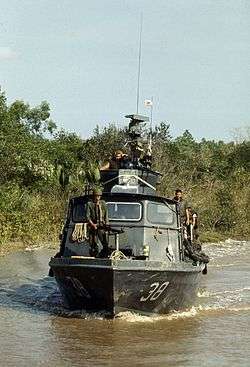Mk 18 Mod 0 grenade launcher

| Mk 18 Mod 0 grenade launcher | |
|---|---|
|
Mk 18 Mod 0 grenade launchers (right and on tripod) at the War Remnants Museum (Ho Chi Minh City) | |
| Type | Grenade launcher |
| Place of origin |
|
| Service history | |
| In service | 1960s - Early 1970s |
| Used by | US Navy |
| Wars | Vietnam War |
| Production history | |
| Manufacturer | Honeywell Corporation and Aeronautical Products Division |
| Number built | 1200 |
| Specifications | |
| Crew | 2 |
|
| |
| Cartridge | 40x46mm grenade |
| Caliber | 40mm |
| Barrels | 1 |
| Action | Hand cranked, manual reloading |
| Rate of fire | 250 rounds per minute |
| Effective firing range | 2200 yards |
| Feed system | belt |
| Sights | Iron |
The Mk 18 Mod 0 was a 40x46mm grenade launcher used by the US Navy during the Vietnam War and also the last known hand crank operated firearm since the Gatling gun. It has been replaced by the Mk 19 in service with the United States Armed Forces.
Design
This weapon is a manually operated, belt fed, rapid-fire 40mm grenade launcher designed to provide coverages of targets with high explosive fragmenting grenades. It will fire at variable rates up to 250 rounds per minute at ranges from approximately 328 yards to 2,200 yards. The rotary split breech, utilized in this weapon, allows straight through feeding of ammunition and eliminates the need for a reciprocating bolt, extraction of ammunition from a belt, extraction from a chamber and ejection for the weapon.The 40mm Mk18 utilizes a split breech concept which has been previously used but has some original characteristics based on the introduction of a mechanism to allow the top rotor to move vertically and synchronizes the bottom rotor. Between 1965 and 1968, approximately 1200 of the Mk18 Mod 0, 40mm multiple grenade launchers were produced by the Honeywell Corporation and Aeronautical Products Division, Hopkins, Minnesota. The first patent application was filed by Honeywell in 1964, however, the initial development work commenced in late 1962. The concept was originally proposed during a study on the behavior of fuzes for the M79 grenade launcher ammunition. Honeywell had anticipated the need for a simple, inexpensive and extremely mobile rapid fire weapon that could provide a team of two with an effective capability for delivering large quantities of explosive grenades within a limited range primarily for suppressive and defensive fire purposes. The development of the 40mm cartridge grenade with its two stage propelling system (essentially an impulse system) made such a weapon possible. The high-low pressure propelling system utilized in the 40mm cartridges permits the use of a split breech mechanism which allows the weapon to be extremely light and simple
Test results
From results of the evaluation it was concluded that the prototype 40mm Mk18 Mod 0 grenade launcher as received from Honeywell Inc. would fire 5,000 rounds without wearout failures. However, during the evaluation, the performance of the gun, especially during the first 3,000 rounds was unsatisfactory because of the high stoppage rate due to faulty ammunition belting, inadequate firing pin protrusion, and the rough cycling action of the weapon at higher rates of fire. It was also recommended that the firing mechanism be modified to prevent inadvertent firing of the round during movement of the firing pin from the safe to fire position. While this concept was soon declared obsolete due to the introduction of the automatic 40mm grenade launcher system, more than 500 of the new weapons had been ordered by the navy from Honeywell, Inc, which developed the weapon in 1963, under contracts of more than $750,000. Designed for use on a low tripod, the small lightweight weapon is capable of firing up to 375 meters at a rate of over 250 rounds a minute. For its navy role, the gun was expected to be mounted atop a .50 caliber machine gun on the stern of each PBR. Two rounds are fired during each full crank revolution; thus, loading occurs at 3 and 9 o'clock, firing at 6 and 12. A three position knob is located at the rear of the gun for "fire", " safe," and "load" control. For the navy, a 48-round ammo box weighing 35 lbs. is used. A 19-lb 24-round box also is available for use in the field. Belts are hand-loaded were reused up to five times. The Mark 18 was used primarily on small boats or in fixed positions such as bunkers; their primary users were the so-called “river rats” and the SEALs. They could be mounted on M-2HB, M-60, or M-1919 tripods or pintle mounts, but could not be fired without such a mount.
.jpg)